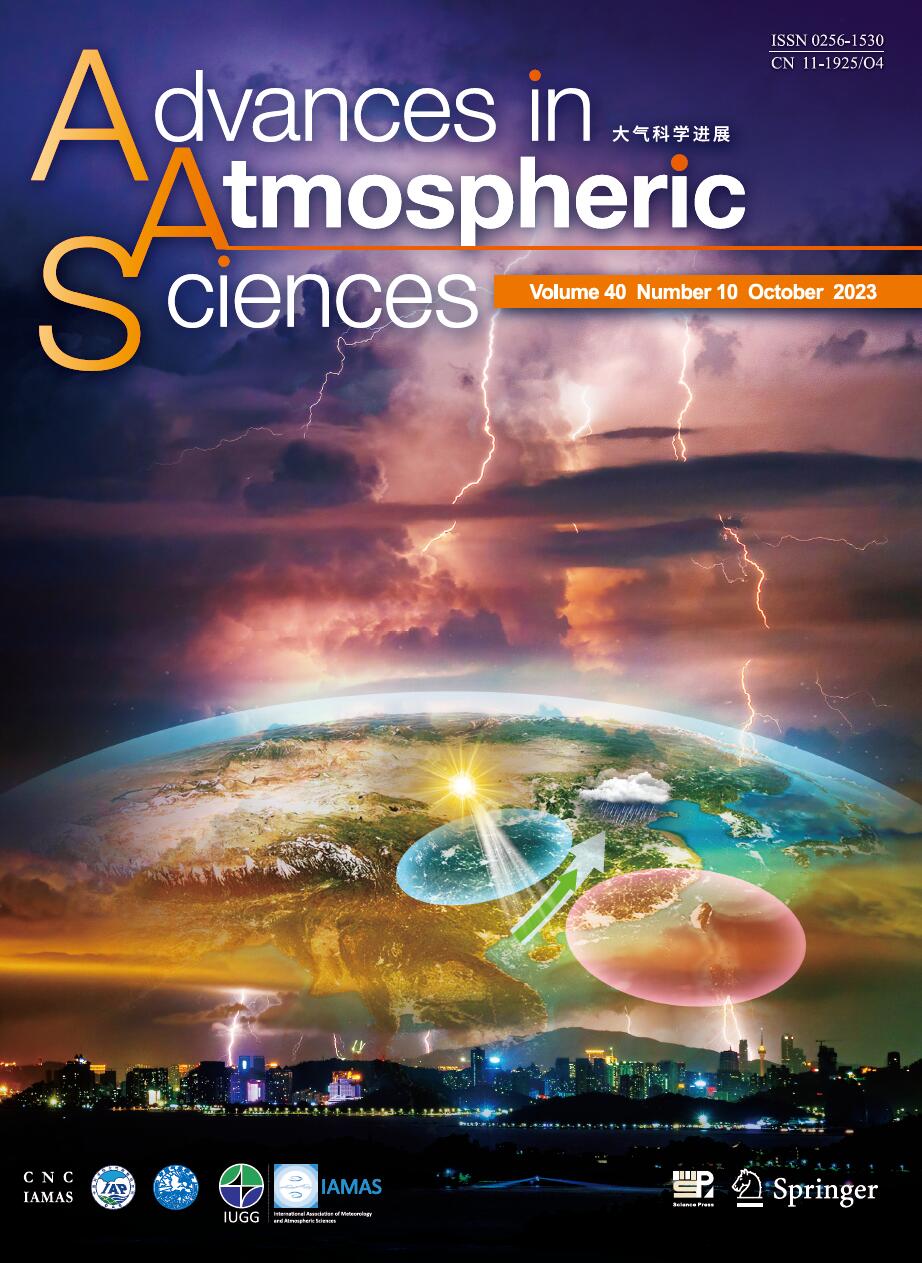| [1] |
XU Yamei, WU Rongsheng,
2003: The Conservation of Helicity in Hurricane Andrew (1992) and the Formation of the Spiral Rainband, ADVANCES IN ATMOSPHERIC SCIENCES, 20, 940-950.
doi: 10.1007/BF02915517
|
| [2] |
Fei Shiqiang, Tan Zhemin,
2001: On the Helicity Dynamics of Severe Convective Storms, ADVANCES IN ATMOSPHERIC SCIENCES, 18, 67-86.
doi: 10.1007/s00376-001-0005-5
|
| [3] |
Ding Jincai, Dai Jianhua, Chen Yamin, Hu Fuquan, Tang Xinzhang,
1996: Helicity as a Method for Forecasting Severe Weather Events, ADVANCES IN ATMOSPHERIC SCIENCES, 13, 533-538.
doi: 10.1007/BF03342043
|
| [4] |
Qu Xiaobo, Julian Heming,
2002: The Impact of Dropsonde Data on Forecasts of Hurricane Debby by the Meteorological Office Unified Model, ADVANCES IN ATMOSPHERIC SCIENCES, 19, 1029-1044.
doi: 10.1007/s00376-002-0062-4
|
| [5] |
Jianjun LIU, Feimin ZHANG, Zhaoxia PU,
2017: Numerical Simulation of the Rapid Intensification of Hurricane Katrina (2005): Sensitivity to Boundary Layer Parameterization Schemes, ADVANCES IN ATMOSPHERIC SCIENCES, 34, 482-496.
doi: 10.1007/s00376-016-6209-5
|
| [6] |
Tan Zhemin, Wu Rongsheng,
1994: Helicity Dynamics of Atmospheric Flow, ADVANCES IN ATMOSPHERIC SCIENCES, 11, 175-188.
doi: 10.1007/BF02666544
|
| [7] |
T. N. Krishnamurti, H. S. Bedi, K. S. Yap, D. Oosterhof,
1993: Hurricane Forecasts in the FSU Models, ADVANCES IN ATMOSPHERIC SCIENCES, 10, 121-132.
doi: 10.1007/BF02656960
|
| [8] |
Da-Lin ZHANG, Xiaoxue WANG,
2003: Dependence of Hurricane Intensity and Structures on Vertical Resolution and Time-Step Size, ADVANCES IN ATMOSPHERIC SCIENCES, 20, 711-725.
doi: 10.1007/BF02915397
|
| [9] |
Tong ZHU, Da-Lin ZHANG,
2006: The Impact of the Storm-Induced SST Cooling on Hurricane Intensity, ADVANCES IN ATMOSPHERIC SCIENCES, 23, 14-22.
doi: 10.1007/s00376-006-0002-9
|
| [10] |
T.N.Krishnamurti, Sheng Jian,
1985: THE HEATING FIELD IN AN ASYMMETRIC HURRICANE -PART I:SCALE ANALYSIS, ADVANCES IN ATMOSPHERIC SCIENCES, 2, 402-413.
doi: 10.1007/BF02677256
|
| [11] |
T.N.Krishnamurti, Sheng Jian,
1985: THE HEATING FIELD IN AN ASYMMETRIC HURRICANE PART II:RESULTS OF COMPUTATIONS, ADVANCES IN ATMOSPHERIC SCIENCES, 2, 426-445.
doi: 10.1007/BF02678742
|
| [12] |
Fu Baopu,
1987: VARIATION IN WIND VELOCITY OVER WATER, ADVANCES IN ATMOSPHERIC SCIENCES, 4, 93-104.
doi: 10.1007/BF02656665
|
| [13] |
Zhao Ming, Xu Yinzi, Wu Rongsheng,
1989: The Wind Structure in Planetary Boundary Layer, ADVANCES IN ATMOSPHERIC SCIENCES, 6, 365-376.
doi: 10.1007/BF02661542
|
| [14] |
ZHENG Jing, Jun LI, Timothy J. SCHMIT, Jinlong LI, Zhiquan LIU,
2015: The Impact of AIRS Atmospheric Temperature and Moisture Profiles on Hurricane Forecasts: Ike (2008) and Irene (2011), ADVANCES IN ATMOSPHERIC SCIENCES, 32, 319-335.
doi: 10.1007/s00376-014-3162-z
|
| [15] |
Lei ZHU, Zhiyong MENG, Yonghui WENG, Fuqing ZHANG,
2022: Assimilation of All-sky Geostationary Satellite Infrared Radiances for Convection-Permitting Initialization and Prediction of Hurricane Joaquin (2015), ADVANCES IN ATMOSPHERIC SCIENCES, 39, 1859-1872.
doi: 10.1007/s00376-022-2015-4
|
| [16] |
MIAO Shiguang, LI Pingyang, WANG Xiaoyun,
2009: Building Morphological Characteristics and Their Effect on the Wind in Beijing, ADVANCES IN ATMOSPHERIC SCIENCES, 26, 1115-1124.
doi: 10.1007/s00376-009-7223-7
|
| [17] |
Federico OTERO, Diego C. ARANEO,
2022: Forecasting Zonda Wind Occurrence with Vertical Sounding Data, ADVANCES IN ATMOSPHERIC SCIENCES, 39, 161-177.
doi: 10.1007/s00376-021-1007-0
|
| [18] |
SHUN Liu, QIU Chongjian, XU Qin, ZHANG Pengfei, GAO Jidong, SHAO Aimei,
2005: An Improved Method for Doppler Wind and Thermodynamic Retrievals, ADVANCES IN ATMOSPHERIC SCIENCES, 22, 90-102.
doi: 10.1007/BF02930872
|
| [19] |
S.K. Sinha, S. Rajamani,
1995: Multivariate Objective Analysis of Wind and Height Fields in the Tropics, ADVANCES IN ATMOSPHERIC SCIENCES, 12, 233-244.
doi: 10.1007/BF02656836
|
| [20] |
Xue Feng, Zeng Qingcun,
1999: Diagnostic Study on Seasonality and Interannual Variability of Wind Field, ADVANCES IN ATMOSPHERIC SCIENCES, 16, 537-543.
doi: 10.1007/s00376-999-0029-9
|















 AAS Website
AAS Website 
 AAS WeChat
AAS WeChat 
 DownLoad:
DownLoad: